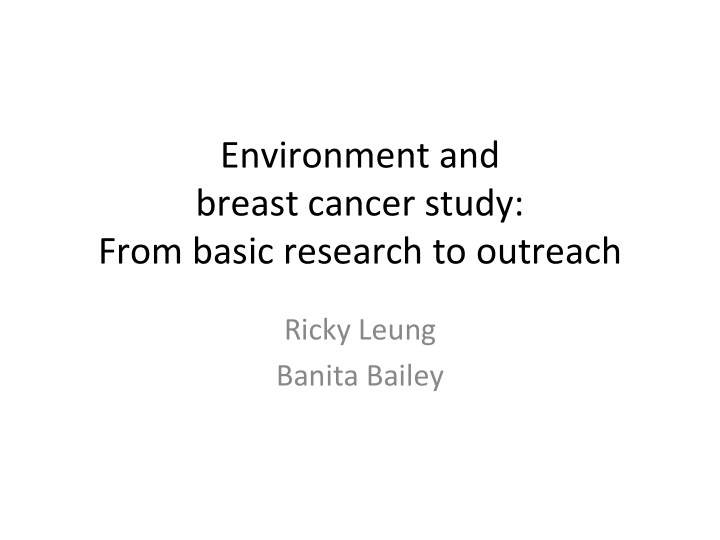



Environment and breast cancer study: From basic research to outreach Ricky Leung Banita Bailey
Breast Cancer and the Environment Breast Cancer and the Environment Research Program (BCERP Program (BCERP) ) Research The goals of the BCERC Program were to: • Compare the molecular changes that occur in normal breast development across the life-span to changes that occur when environmental exposures are introduced; • Conduct epidemiologic studies of the timing of female pubertal events, including the onset of breast development, age at menarche, and environmental and genetic factors that may affect pubertal maturation; • Integrate scientific information on the development of the mammary gland and exposure-induced changes in order to construct public health messages for young girls and women who may be at increased risk for breast cancer.
Breast Cancer and the Environment Research Research Breast Cancer and the Environment Program ( (BCERP) BCERP) Program
Endocrine disruptor: ndocrine disruptor: Bisphenol Bisphenol A (BPA) A (BPA) E Polycarbonate plastics- a hard plastic Polycarbonate plastics- a hard plastic Epoxy resins Epoxy resins • Production of 1.6 billion pounds in North American. BPA is ubiquitously present in the environment
Hypothesis: Hypothesis: Environment Diet Fat in Bisphenol A In utero exposure Cultural Diets Altered epigenome, gene expression and hormones Steroid hormones Leptin Adipokines Adiponectin Leads to changes in cell behavior and morphology => Increased BCa risk
Aim 1: What is the most effective BPA dose that can synergize with a high-fat-butter diet (HFB)? DMBA Acclimation Gestation Lactation Mating (14 days) (23 days) (21 days) (14 days) -51 -37 -23 P0 P21 P50 P140 Control Diet Control diet HFB + 0 BPA Control diet HFB + 2.5 BPA Control diet Reference HFB + 25 BPA Control diet Dose By Control diet HFB + 250 BPA USEPA Control diet HFB + 2500 BPA HFB + 0.5 EE2 Control diet n=11/group n=11/group n=33/group n=22/group One animal per litter was used Dose is in µg/Kg B.W. One animal per litter was used Dose is in µg/Kg B.W.
Butter- Aim 2: Which type of fat is harmful or saturated Olive oil protective in combination with BPA? MUFA Safflower- -3/ -6 PUFA -6 Acclimation Mating Gestation Lactation DMBA (14 days) (<=10 days) (23 days) (21 days) P0 P21 P50 P140 -51 -37 -27 Control diet Control diet AIN + 25 BPA Control diet HF0 Control diet HF0 + 25 BPA Control diet HFB Control diet HFB + 25 BPA Control diet Control diet HFS Control diet HFS + 25 BPA AIN + 0.5 EE2 Control diet n=15/group
Summary of our finding Summary of our finding • BPA (25µg/Kg BW)in the presence of butter diet (HFB) showed significant higher tumor incidence and lower percentage of tumor free survival when compared with butter diet alone. • HFB lowers BPA’s lowest observed adverse effect level (LOAEL) by 10 times (25µg/Kg BW, non- monotonic dose-response). • HFB shifts the cancer-susceptibility window back to Day 50.
Research and Outreach Team Research and Outreach Team http://www.eh.uc.edu/mythfactchoices/ Traci Metzger Dr. Shuk-Mei Ho Dr. Marian Miller Dr. Vinothini Banita Bailey RN Dr. Linda Levin Dr. Ricky Leung Janakiram
Outreach activities Outreach activities
Newsletters Newsletters
Survey and responses Survey and responses Aim: To survey breast cancer survivors, supporters and families with respect to their interest in, and knowledge of, the potential impact of epigenetics on health. • On a sliding scale of 1 – 5 with 5 being the most interested, 3.5 was the mean interest levels. • Most individuals did not recognize maternal diet and environment were relevant for breast cancer risk in male offspring • 40% of individuals between 14 - 19 yo preferred to be educated with videos • 30% of individuals 45-54 preferred emails and links
Our website Our website http://www.eh.uc.edu/mythfactchoices/
Self breast exam reminders
Online Games Online Games Wordsearch puzzles Crossword puzzles Memory matching game Jigsaw puzzles
Recommend
More recommend